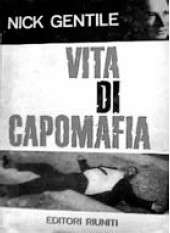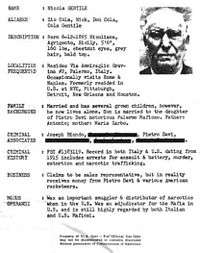Nicola Gentile
| Nicola Gentile | |
|---|---|
|
Nick Gentile's FBI file | |
| Born |
June 12, 1885 Siculiana, Italy |
| Died |
November 6, 1966 Siculiana, Italy |
| Other names | Zu Cola |
| Known for | Writing memoirs about his time in the Mafia |
| Allegiance | Sicilian Mafia |
Nicola Gentile (June 12, 1885 – November 6, 1966),[1][2] also known as Nick Gentile, was a Sicilian mafioso and an organized crime figure in New York City during the 1920s and 1930s. He was also known for publishing his memoirs which, violating the mafiosi code known as omerta, revealed many details of the Sicilian and American underworld. Gentile was born in Siculiana, a small village on the south coast of Sicily in the province of Agrigento. He immigrated to the United States arriving in New York at age 18, in 1903. Gentile fled the country in 1937 while out on $15,000 bail after an arrest for heroin trafficking and returned to Sicily to become a boss in the Sicilian Cosa Nostra. In the US, he was known as "Nick" and in Sicily as "Zu Cola" (Uncle Cola).
Arrival in the United States
After Nick Gentile arrived in the United States from Sicily in 1903, he quickly associated with the Black Hand during the early 20th century, Gentile would become a leader in America's early mafia and would later serve as a confidant for New York mobsters throughout the early part of the 20th century up until the Castellammarese War and the subsequent formation of New York's Five Families under Charles "Lucky" Luciano in 1931. Gentile traveled the country as a troubleshooter and negotiator,[3] known as the messaggero or substituto, relaying messages between crime families and mediating disputes and became part of New York Mafia Family led by Vincent Mangano and Joe Biondo, which later became known as the Gambino Family.[4]
During Prohibition, Gentile was briefly involved in bootlegging as head of criminal syndicates in Kansas City, Cleveland and Pittsburgh. In 1920, there was an attempt made on his life by his rival in Cleveland, mafia boss Joseph "Big Joe" Lonardo. Gentile left for Sicily, but not before he met with his New York allies. He decided to align himself with New York mafia bosses Rocco Valenti and Salvatore Mauro against Salvatore "Totò" D'Aquila and Joe Lonardo, who backed mafia boss, Giuseppe "Joe the Boss" Masseria in his bid to gain control of the Morello crime family in which Rocco Valenti and Joe Masseria were both high level members.[5]
Gentile returned to the United States after several months in Sicily. His allies Mauro and Valenti were gunned down by Masseria forces in 1920 and 1922, ending the conflict and making Joe Masseria one of the top mafia bosses in New York. Gentile continued his criminal career in New York now aligning himself with the group of Charles "Lucky" Luciano.[6] Gentile became involved with Luciano's narcotics operations. He was arrested in New Orleans in 1937 on drug charges. Soon after his arrest Gentile fled the country while out on $15,000 bail and returned to Sicily.[7][8]
Return to Sicily
In Sicily, Gentile rose to a high-level position in the Sicilian Mafia. His power and influence grew after the Allied invasion of Sicily in 1943 (Operation Husky as he helped the military set up its civil administration – the American Military Government of Occupied Territories (AMGOT) – in the Agrigento province. He became involved in intelligence and the Sicilian separatist movement.[9]
Gentile claimed to have been approached by U.S. special agent Max Brod to support the monarchy in the referendum on June 2, 1946.[10][11] Later, he became an important canvasser for politicians from the Christian Democrat party (Democrazia Cristiana, DC), who quarrelled for his support.[4] Gentile later supported Christian Democrat Giuseppe La Loggia, who would become president of the autonomous region of Sicily from 1956–58.[12]
When Lucky Luciano was extradited to Italy in 1946, he once again teamed up with Gentile in organizing drug routes to the US. Gentile had very good connections with well-known drug traffickers in Sicily. His son was married to the daughter of Pietro Davì, one of the leading figures in cigarette smuggling and illicit drug trade in Palermo in the 1950s.[4] Gentile and Luciano met New York gangster Joe Biondo in 1949.[4] Biondo supervised the Gambino Family's heroin traffic.[13]
Gentile provided information to the KGB, through journalist Leonid Kolosov, during the Cold War[14] and remained a prominent figure in the Sicilian underworld throughout the 1950s and 1960s. He was erroneously believed by some to have replaced Calogero Vizzini as the head of the Sicilian Mafia.[15]
Memoirs

In 1963 Gentile wrote down his memoirs, "Vita Di Capomafia", with the help of Italian journalist Felice Chilanti. The long forgotten book described the internal organization of the Mafia, or "l'onorata società" (the Honoured Society) as Gentile called it, more than 20 years before Tommaso Buscetta emerged as the important first pentito who broke with omertà and told Cosa Nostra's inside story. Gentile was already more explicit than Buscetta in his first confessions. Gentile undiffidently talked about his links with politicians for whom he acted as a canvasser.[12]
According to crime reporter Hank Messick, a resentful Gentile confessed to the FBI. In fact, his memoirs were for sale in every bookshop in Italy. The FBI used Gentile's information to corroborate the testimony of former mobster turned government informant Joe Valachi in 1963. The memoirs were shown to American Mafia turncoat Joe Valachi who vouched for its accuracy and said Gentile 'wrote just the way it is'.[8][16]
Gentile's fellow mafiosi did not appreciate his candor and sentenced him to death, but the Catania Mafia clan who had to kill him declined to do so, according to pentito Antonio Calderone. At the end of his days, Gentile was a pitiful figure who only survived through the pasta which his neighbours gave him.[17][18][19]
References
- Notes
- ↑ Critchley, The Origin of Organized Crime in America, p. 170; see also Gentile's FBI file in the infobox
- ↑ "FBI RIDs Dead List 2015". archive.org. Retrieved 2017-05-05.
- ↑ Dash, The First Family, pp. 139-43
- 1 2 3 4 The Rothschilds of the Mafia on Aruba, by Tom Blickman, Transnational Organized Crime, Vol. 3, No. 2, Summer 1997
- ↑ Critchley, The Origin of Organized Crime in America, pp. 155-58
- ↑ (in Italian) Chilanti, Vito di capomafia, p. 15
- ↑ (in Italian) Chilanti, Vito di capomafia, p. 151-53
- 1 2 Messick, Lansky, p.49
- ↑ (in Italian) Chilanti, Vito di capomafia, p. 169
- ↑ (in Italian) Chilanti, Vito di capomafia, pp. 166-68
- ↑ (in Italian) Giugno 1946: la mafia si schierò con i Savoia?, Michele Vaccaro, Storia in rete, Settembre-Ottobre 2012
- 1 2 (in Italian) Chilanti, Vito di capomafia, p. 172
- ↑ Davis, Mafia Dynasty, p. 101
- ↑ KGB spies' book reveals stories behind espionage, Associated Press, October 1, 1998
- ↑ Lewis, The Honoured Society, p. 146
- ↑ Mafioso's memoirs support Valachi’s testimony, New York Times, April 11, 1971
- ↑ (in Italian) Arlacchi, Gli uomini del disonore, p. 158
- ↑ Dickie, Cosa Nostra, p. 231.
- ↑ Critchley, The Origin of Organized Crime in America, p. 168
- Sources
- (in Italian) Arlacchi, Pino (1992). Gli uomini del disonore. La mafia siciliana nella vita del grande pentito Antonio Calderone, Milan: Mondadori ISBN 88-04-35326-0
- (in Italian) Caruso, Alfio (2000). Da cosa nasce cosa. Storia della mafia del 1943 a oggi, Milan: Longanesi ISBN 88-304-1620-7
- Critchley, David (2009). The Origin of Organized Crime in America: The New York City Mafia, 1891-1931, New York: Routledge, ISBN 0-415-99030-0
- Dash, Mike (2009). The First Family: Terror, Extortion, Revenge, Murder, and the Birth of the American Mafia, New York: Random House, ISBN 978-1-4000-6722-0
- Davis, John H. (1993). Mafia Dynasty. The Rise and Fall of the Gambino Crime Family, New York: HarperCollins
- Dickie, John (2004). Cosa Nostra. A history of the Sicilian Mafia, London: Coronet, ISBN 0-340-82435-2
- (in Italian) Gentile, Nick & Felice Chilanti (1963), Vita di capomafia, Rome: Editori Riuniti.
- Lewis, Norman (1964/2003). The Honoured Society: The Sicilian Mafia Observed, London: Eland, ISBN 0-907871-48-8
- Messick, Hank (1973). Lansky. London: Robert Hale & Company, ISBN 0-7091-3966-7
- Scott, Peter Dale (1993). Deep Politics and the Death of JFK. Berkeley: University of California Press, ISBN 0-520-08410-1
External links
- (in Italian) Il memoriale dimenticato, Antimafia Duemila, January 2004 (Free registration)
- The American "Mafia": Who Was Who ? Nicola Gentile
- Nicola Gentile - Meet the Mafia's Most Elusive Yet Revealing Historical Figure, article by Christian Cipollini
